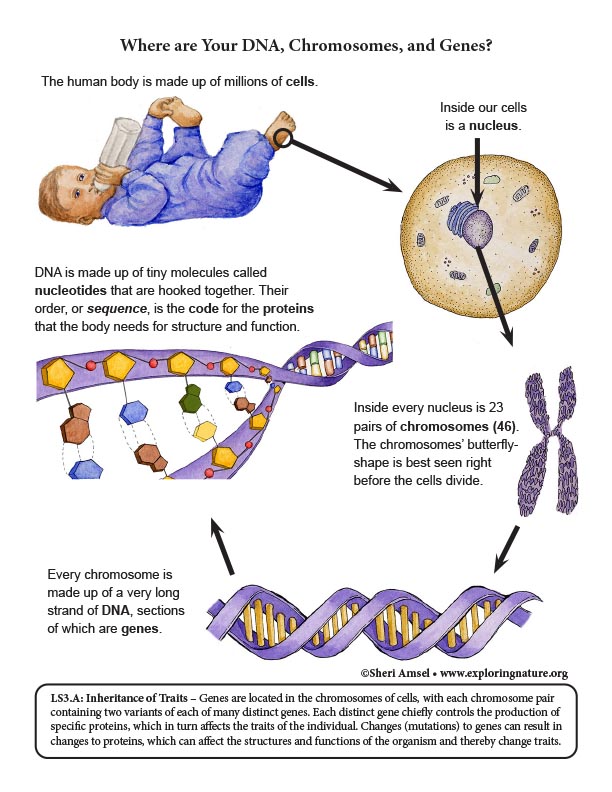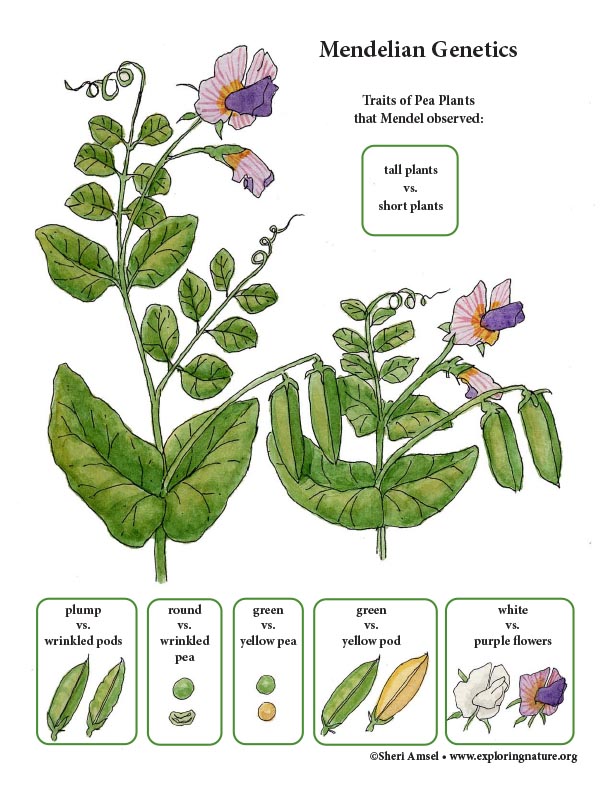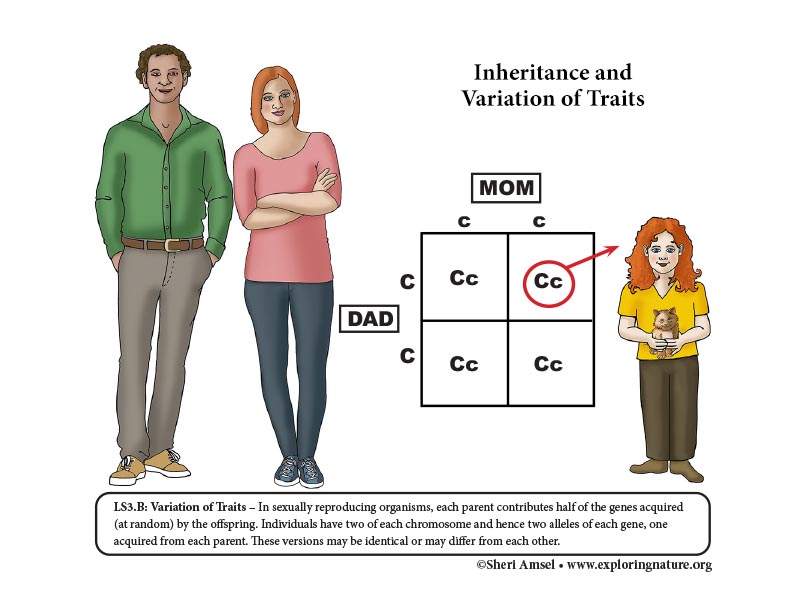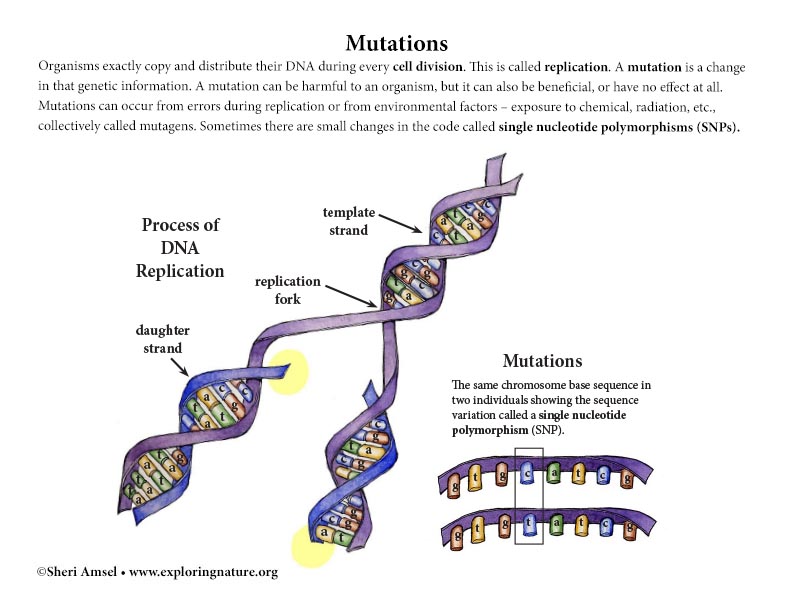

_________________________________________________________________________________________________________________________________________________________
Disciplinary Core Ideas
LS1.B: Growth and Development of Organisms
• Organisms reproduce, either sexually or asexually, and transfer their genetic information to their offspring. (secondary to MS-LS3-2)
LS3.A: Inheritance of Traits
• Genes are located in the chromosomes of cells, with each chromosome pair containing two variants of each of many distinct genes. Each distinct gene chiefly controls the production of specific proteins, which in turn affects the traits of the individual. Changes (mutations) to genes can result in changes to proteins, which can affect the structures and functions of the organism and thereby change traits. (MS-LS3-1)
• Variations of inherited traits between parent and offspring arise from genetic differences that result from the subset of chromosomes (and therefore genes) inherited. (MS-LS3-2)
LS3.B: Variation of Traits
• In sexually reproducing organisms, each parent contributes half of the genes acquired (at random) by the offspring. Individuals have two of each chromosome and hence two alleles of each gene, one acquired from each parent. These versions may be identical or may differ from each other. (MS-LS3-2)
• In addition to variations that arise from sexual reproduction, genetic information can be altered because of mutations. Though rare, mutations may result in changes to the structure and function of proteins. Some changes are beneficial, others harmful, and some neutral to the organism. (MS-LS3-1)
_________________________________________________________________________________________________________________________________________________________
Use the Template and Resource Links to Fulfill NGSS
l. Goals:
Essential Questions:
NGSS Note: Think, question, entertain ideas.
ll. Introductory Activities to Assess Prior Knowledge
A. Simple Activities - that assess students’ understanding of gene and traits.
Sexual vs. Asexual Reproduction Offspring - Punnett Square Activity
Simple Activities - that assess students’ understanding of traits.
Make a flow chart from chromosome to trait (like hair color), including naming all the processes along the way.
B. Brainstorming Sessions
Question: Can you make a flow chart starting with the cell down to the gene and then to a physical trait? What are the structures and processes involved in the coding for a human trait like hair color?
1. Break students down into groups of 3-4.
2. Ask students to generate a flow chart starting with the cell down to the gene and then to a physical trait. Don't forget to add any of the processes, like transcription, along the way.
3. Discuss using the Genes to Traits Flow Chart and RNA Translation in the diagrams below.
lll. New Knowledge - Text
A. Read about:
Gregor Mendel's Genetics Discoveries with Peas
The Genetic Code – What Exactly is it?
Important Role of Proteins in… Everything
Predicting Genetics Traits - The Punnett Square
Proteins - Their Important Role in… Everything
RNA Translation - RNA and the Ribosomes' Role in Protein Synthesis
Sexual Reproduction vs. Asexual Reproduction
Asexual Reproduction - A Forest of Clones
B. Examples of Models (depicts the concept expressed in the reading):
Ask students to look at the models and explain how each illustrates the concepts they read about.
lV. Experiments, Activities, Model-making (Critical Thinking)
A. Critical Thinking Activities related to genes and traits:
Using Punnett's Square to Show Mendel's Genetics Discoveries
Traits and Characteristics - Critical Thinking Activity
Create the Kids - Genetics Activity Worksheet
Researching Asexual Reproduction - Worksheet
V. Summarize Knowledge - Enduring Understandings
Vl. New Generation of Science Standards (NGSS) - Middle School Life Science
Disciplinary Core Ideas
LS1.B: Growth and Development of Organisms
• Organisms reproduce, either sexually or asexually, and transfer their genetic information to their offspring. (secondary to MS-LS3-2)
LS3.A: Inheritance of Traits
• Genes are located in the chromosomes of cells, with each chromosome pair containing two variants of each of many distinct genes. Each distinct gene chiefly controls the production of specific proteins, which in turn affects the traits of the individual. Changes (mutations) to genes can result in changes to proteins, which can affect the structures and functions of the organism and thereby change traits. (MS-LS3-1)
• Variations of inherited traits between parent and offspring arise from genetic differences that result from the subset of chromosomes (and therefore genes) inherited. (MS-LS3-2)
LS3.B: Variation of Traits
• In sexually reproducing organisms, each parent contributes half of the genes acquired (at random) by the offspring. Individuals have two of each chromosome and hence two alleles of each gene, one acquired from each parent. These versions may be identical or may differ from each other. (MS-LS3-2)
• In addition to variations that arise from sexual reproduction, genetic information can be altered because of mutations. Though rare, mutations may result in changes to the structure and function of proteins. Some changes are beneficial, others harmful, and some neutral to the organism. (MS-LS3-1)
Science and Engineering Practices (NGSS)
Developing and Using Models
Modeling in 6–8 builds on K–5 experiences and progresses to developing, using, and revising models to describe, test, and predict more abstract phenomena and design systems.
• Develop and use a model to describe phenomena. (MS-LS3-1),(MS-LS3-2)
Crosscutting Concepts (NGSS)
Cause and Effect
• Cause and effect relationships may be used to predict phenomena in natural systems. (MS-LS1-8)
• Phenomena may have more than one cause, and some cause and effect relationships in systems can only be described using probability. (MS-LS3-2)
Structure and Function
• Complex and microscopic structures and systems can be visualized, modeled, and used to describe how their function depends on the relationships among its parts, therefore complex natural structures/systems can be analyzed to determine how they function. (MS-LS3-1)
Performance Expectations
Students who demonstrate understanding can:
MS-LS3-1. Develop and use a model to describe why structural changes to genes (mutations) located on chromosomes may affect proteins and may result in harmful, beneficial, or neutral effects to the structure and function of the organism.
[Clarification Statement: Emphasis is on conceptual understanding that changes in genetic material may result in making different proteins.] [Assessment Boundary: Assessment does not include specific changes at the molecular level, mechanisms for protein synthesis, or specific types of mutations.]
MS-LS3-2. Develop and use a model to describe why asexual reproduction results in offspring with identical genetic information and sexual reproduction results in offspring with genetic variation.
[Clarification Statement: Emphasis is on using models such as Punnett squares, diagrams, and simulations to describe the cause and effect relationship of gene transmission from parent(s) to offspring and resulting genetic variation.]
When you research information you must cite the reference. Citing for websites is different from citing from books, magazines and periodicals. The style of citing shown here is from the MLA Style Citations (Modern Language Association).
When citing a WEBSITE the general format is as follows.
Author Last Name, First Name(s). "Title: Subtitle of Part of Web Page, if appropriate." Title: Subtitle: Section of Page if appropriate. Sponsoring/Publishing Agency, If Given. Additional significant descriptive information. Date of Electronic Publication or other Date, such as Last Updated. Day Month Year of access < URL >.
Amsel, Sheri. "LS3.A and LS3.B Inheritance and Variation of Traits, LS1.B: Growth and Development of Organisms (LS3 Heredity)" Exploring Nature Educational Resource ©2005-2024. March 30, 2024
< http://exploringnature.org/db/view/1924 >







